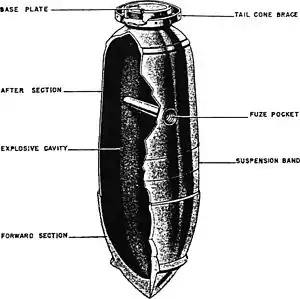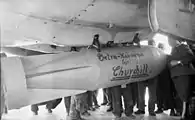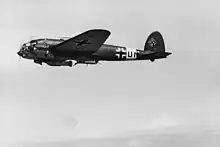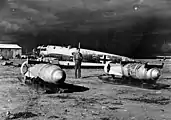SC1000 bomb
The SC 1000 (Sprengbombe Cylindrisch 1000) or cylindrical explosive bomb was a large air-dropped general-purpose thin-cased high explosive demolition bomb used by Germany during World War II. Weighing more than 1,000 kg (2,200 lb), it was nicknamed the Hermann by the Germans in reference to the Luftwaffe commander, Hermann Göring.[1]
| SC 1000 | |
|---|---|
 SC 1000 in cross-section without tail | |
| Type | General purpose HE bomb |
| Place of origin | Germany |
| Service history | |
| In service | from December, 1941 |
| Used by | Luftwaffe |
| Specifications | |
| Mass |
|
| Length |
|
| Diameter |
|
| Filling | Amatol (40%) / Trotyl (60%) Trialen 105 |
| Filling weight |
|
Design
In December 1941, the bomb had a body of drawn steel to which a heavy pointed nose cone was welded. At the other end was a base plate, just forward of which the magnesium alloy tail was tack welded onto the body, and also bolted to the tail attachment brace. Around the nose of the bomb was a kopfring - a metal ring, triangular in cross section, designed to prevent ground penetration or to stop forward momentum when hitting water. The bomb was attached to the aircraft horizontally by a H-type suspension lug.[2]
The bomb was fitted with a single transverse fuse pocket. The bomb was usually filled with a mixture of 40% amatol and 60% Trotyl, but when used as an anti-shipping bomb it was filled with Trialen 105, a mixture of 15% hexogen, 70% Trotyl and 15% aluminium powder. A central exploder tube of high-grade TNT was put down the centre of the explosive to ensure high order detonation.[2]
The bombs were painted sky-blue with a yellow stripe in the tail cone, unless filled with Trialen in which case it was replaced by the silhouette of a sinking ship in yellow, and the warning Nur gegen Handelsschiffe ("only against merchant ships") was stencilled on the bomb casing.[2]
Variants
There were three variants of the bomb, designated Type C, L and L2, all of the same design, but which varied slightly in size and weight.[2]
Fuses
The bomb was fitted with a variety of fuses including:
- Type 25B electric impact fuse. This could be set to instantaneous detonation, short delay (less than 1 second), or for a 17-second delay.[3]
- Type 28B, 38 and 38A electric impact fuse, designed for use against shipping.[4]
Post-war unexploded bombs
Unexploded ordnance can pose a risk of explosion even after a century or more, and some can explode fully if disturbed or even spontaneously. Many unexploded devices from the Second World War are found until this day, including Hermann bombs in Europe, requiring evacuation of people nearby while they are dealt with. They must sometimes be destroyed by detonation if no safer way is possible, and may cause damage despite precautions.
London 2008
In early June 2008 an SC 1000 bomb was dredged from the River Lea near Three Mills Island in London, the largest bomb found in 30 years. The explosive charge was liquefied and pumped out using steam by bomb disposal experts from the Royal Engineers, exposing the detonator, which was made safe with a small detonation after five days. The always-present risk of a full detonation was avoided.[5][6][7]
Szczecin 2013
In June 2013, an SC 1000 bomb was recovered from the Odra in central Szczecin, Poland. The area was evacuated while the bomb was lifted from the river by military engineers, and then taken in convoy to an Army training base near Drawsko Pomorskie to be destroyed in a controlled explosion.[8][9]
Belgrade 2013
In early December, an SC1000 bomb was recovered in the inner city of Belgrade. The area was evacuated while the bomb was lifted by the engineers of the Department for the Unexploded Ordnance of the Sector for Emergency Management of the Ministry of Interior, and then taken in a convoy to an Army training base at Nikinci to be destroyed in a controlled explosion.[10]
Exeter 2021
On 26 February 2021 an unexploded SC1000 bomb was found by builders near the University of Exeter in Exeter in the United Kingdom.[1] A major incident was declared, residents were evacuated, a 400-meter evacuation zone was established, and a controlled detonation was performed on 27 February. Despite precautions, houses within 100m were damaged, a large crater was formed, and debris was thrown 250m away.[11]
Hauerseter leir 2022
On 30 November 2022, an unarmed SC1000 bomb was found by using a metal detector in a small lake known for previously containing miscellaneous artifacts from the past. The bomb is said to be in "pristine" condition by being preserved in an unusually low oxygen environment.[12]
Photo gallery
 A SC 1000 with a personalized message for Mr. Churchill in Belgium 1940.
A SC 1000 with a personalized message for Mr. Churchill in Belgium 1940. A Heinkel He 111 (code marking 1H DN) of KG 26 with an SC 1000 bomb suspended from its fuselage in March 1941.
A Heinkel He 111 (code marking 1H DN) of KG 26 with an SC 1000 bomb suspended from its fuselage in March 1941. Two SC 1000 bombs with "kopfrings", stored on sledges in front of a wrecked German Heinkel He 111H bomber at Benghazi airfield Libya in early 1943.
Two SC 1000 bombs with "kopfrings", stored on sledges in front of a wrecked German Heinkel He 111H bomber at Benghazi airfield Libya in early 1943.
References
- Notes
- Church, Edward (28 February 2021). "Exeter WW2 device was 1,000kg Nazi blitz bomb". DevonLive.
- TM 9-1985-2 (1953), pp. 9–10
- TM 9-1985-2 (1953), p. 141
- TM 9-1985-2 (1953), pp. 163–166
- "WWII bomb defused near Olympics site". CNN. 6 June 2008.
- "WW2 bomb detonated". bbc.co.uk. 5 June 2008. Retrieved 15 June 2013.
- Singh, Rob (5 June 2008). "The ticking Blitz bomb that threatens east London". London Evening Standard.
- Adamowska, Monika; Łukaszuk, Anna (30 June 2013). "To była niemiecka bomba Herman. Została już zdetonowana na poligonie". szczecin.gazeta.pl (in Polish). Retrieved 1 July 2013.
- "Wojsko wyciąga bombę z Odry. Wielka ewakuacja Starego Miasta". szczecin.gazeta.pl (in Polish). 30 June 2013. Retrieved 1 July 2013.
- "Izvadena bomba, danas deaktiviranje" [Bomb is removed today and deactivated]. b92.net (in Serbian). 8 December 2013. Retrieved 8 December 2013.
- "Exeter WW2 bomb detonated after homes evacuated". BBC News. 27 February 2021. Retrieved 28 February 2021.
- "Fant historisk bombe på 500 kilo: − Jeg ble veldig gira".
- "Specijalci izvadili minu s dna riječke luke". index.hr (in Croatian). Retrieved 19 March 2023.
- Bibliography
- "Army Technical Manual TM 9-1985-2/Air Force Technical Order TO 39B-1A-9 German Explosive Ordnance (Bombs, Fuses, Rockets, Land Mines, Grenades & Igniters)" (PDF). HyperWar. March 1953. Retrieved 15 June 2013.